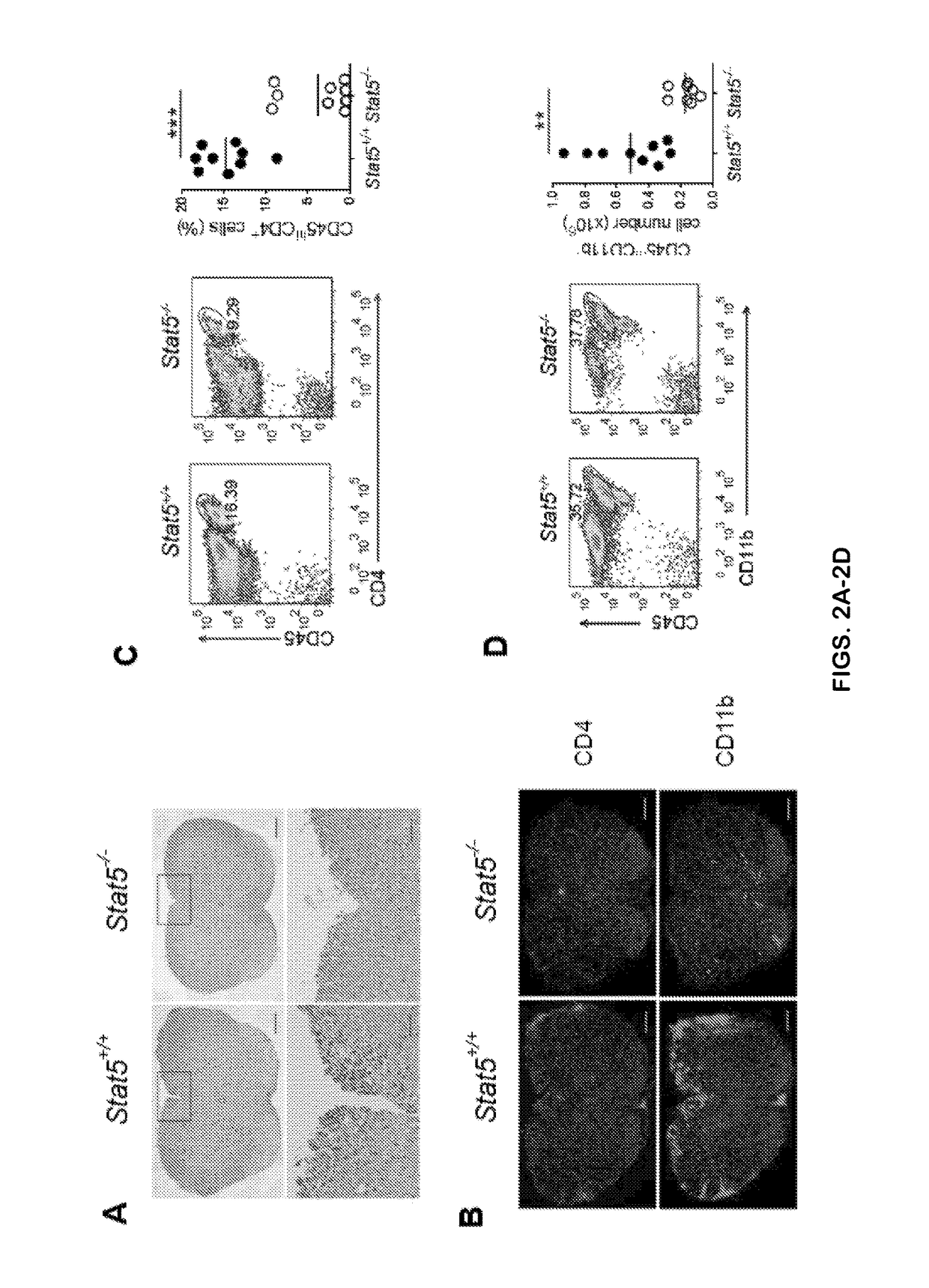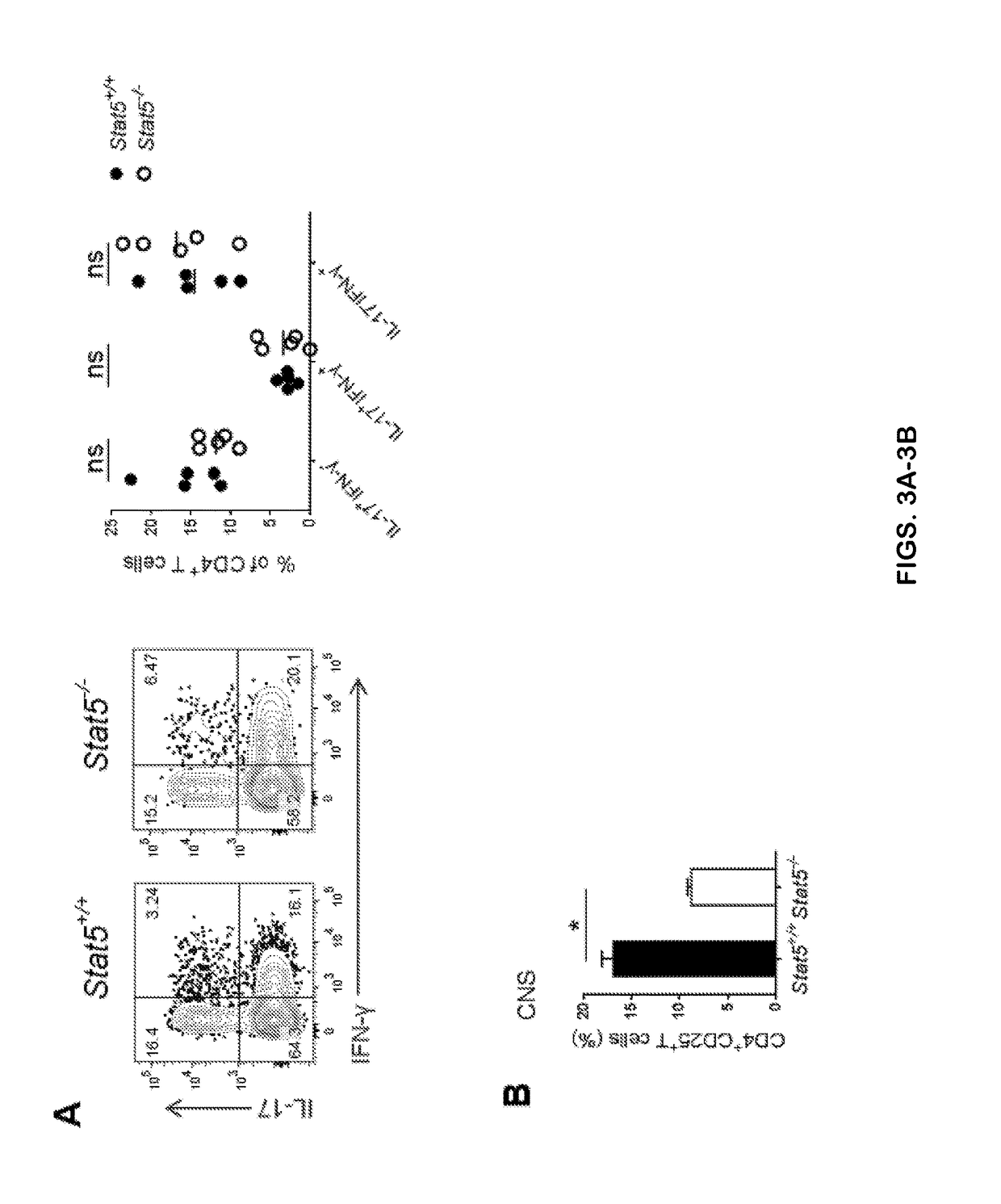Methods and Compositions for Modulating TH-GM Cell Function
a th-gm cell and function technology, applied in the field of methods and compositions for modulating th-gm cell function, can solve the problems of significant unmet need for effective treatment methods, more difficult to identify potential drug targets for ms therapy, etc., and achieve the effect of more targeted and tailored
- Summary
- Abstract
- Description
- Claims
- Application Information
AI Technical Summary
Benefits of technology
Problems solved by technology
Method used
Image
Examples
example 1
ditional Knockout Mice are Resistant to EAE
[0151]STAT5 negatively regulates TH17 differentiation by restraining IL-17 production (Laurence et al., 2007; Yang et al., 2011). However, the function of STAT5 in TH17-mediated pathogenesis is not well understood. To explore this question, EAE was induced in Cd4-Cre; Stat5f / f (Stat5− / −) mice, where Stat5 was specifically deleted in T cell compartment, and in littermate controls by immunizing the mice with MOG35-55 / CFA at day 0 and day 7. Development of paralysis was assessed by daily assignment of clinical scores. Surprisingly, diminished occurrence and severity of clinical disease in Stat5− / − mice was observed (FIGS. 1A and 1B), a result that was opposite to expectations based on an antagonistic role for STAT5 in TH17 generation. Similar results were observed when a single MOG35-55 / CFA immunization was performed or replaced CFA with LPS as the adjuvant to induce EAE (FIGS. 1C and 1D). Consistent with reduced EAE disease in Stat5− / − mice, ...
example 11
iates Experimental Arthritis in a TNF-α-Independent Manner
[0173]The elevation of GM-CSF and TNF-α level in plasma of RA in comparison to HC may suggest a therapeutic approach by targeting these two cytokines. The efficacy of blocking both GM-CSF and TNF-α was tested in treating arthritic mice in antigen-induced arthritis (AIA) model, which is a T-cell driven RA model and is easily inducible in C57BL / 6 strain with a rapid and synchronized disease onset, facilitating the exploration of RA pathogenesis. Either GM-CSF or TNF-α individual blockade attenuated AIA development (FIG. 25A). Interestingly, the combination of GM-CSF− and TNF-α-specific neutralizing antibodies showed better efficacy in controlling arthritis development than individual treatments (FIG. 25A). That is, targeting GM-CSF may have beneficial efficacy in treating arthritis in a way independent of TNF-α activity. To further study the distinguishable effects of GM-CSF and TNF-α in mediating arthritis development, a mouse...
example 13
rived GM-CSF Mediates Neutrophil Accumulation in Synovial Tissues
[0180]The mechanism by which GM-CSF-producing Th cells evoke synovial inflammation and drive arthritis development was examined. Myeloid lineage-derived cells, including neutrophils, DCs and macrophages, express GM-CSF receptor and are common targets of GM-CSF (Hamilton, 2008). Importantly, those cells invade synovial compartments in RA patients and mouse arthritis models, and contribute to synovitis (McInnes and Schett, 2011). The infiltration of myeloid lineage-derived cells in synovial compartments of AIA mice was examined. CD11b+ myeloid cells represented a predominant population (˜70%) among synovial infiltrating leukocytes (FIG. 31B). Although CD4+ TH cell infiltration was not altered by STAT5 deletion, synovial CD11b+ cell infiltration was significantly reduced in Stat5− / − mice compared with Stat5+ / + mice when examined at day 7 after arthritis induction (FIG. 31B). This reduction is unlikely due to defective hem...
PUM
| Property | Measurement | Unit |
|---|---|---|
| Fraction | aaaaa | aaaaa |
| Fraction | aaaaa | aaaaa |
| Fraction | aaaaa | aaaaa |
Abstract
Description
Claims
Application Information
 Login to View More
Login to View More - R&D
- Intellectual Property
- Life Sciences
- Materials
- Tech Scout
- Unparalleled Data Quality
- Higher Quality Content
- 60% Fewer Hallucinations
Browse by: Latest US Patents, China's latest patents, Technical Efficacy Thesaurus, Application Domain, Technology Topic, Popular Technical Reports.
© 2025 PatSnap. All rights reserved.Legal|Privacy policy|Modern Slavery Act Transparency Statement|Sitemap|About US| Contact US: help@patsnap.com



